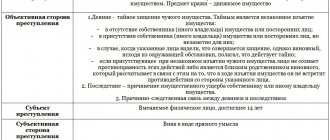Despite the fact that the standard of living is declining, the number of burglaries in Russia has recently decreased. However, one should not be consoled by this fact, because the number of episodes annually exceeds 100,000. Thieves identify apartments of wealthy people based on several criteria: the presence of air conditioning, satellite dishes, insulation of housing, expensive doors. In addition, attacks based on a tip are possible.
Single thefts are more common than acts committed by a group of people. Typically, criminals collectively act on a tip if there is actually a lot of property on the premises that is of interest to thieves. In addition, acts without prior agreement are possible.
These types of cases are complex and legal proceedings can take a long time. If you need the help of a qualified lawyer, our specialists are ready to help.
Criminal punishment for theft by a group of persons
The classification of acts and punishment for theft are provided for in Art. 158 of the Criminal Code of the Russian Federation, and for illegal actions committed by a group of persons - in Art. 35 of the Criminal Code of the Russian Federation. Crimes of this kind are determined by several criteria, the key ones being:
- number of participants;
- existence of a preliminary conspiracy;
- damage caused as a result of theft.
The peculiarity of the theft as such is its secret nature and the absence of bodily injury or other harm to the health of the victim. If such acts are accompanied by beatings, proceedings are initiated under Art. 161 for robbery. If a crime is committed with the use of a weapon, liability will arise under Art. 162 for robbery.
Theft without aggravating factors is qualified under Part 1 of Art. 158 of the Criminal Code of the Russian Federation. It provides for the following penalties:
- a fine in the amount of 200,000 rubles or the income of the attackers for 18 months;
- correctional labor for up to 2 years;
- imprisonment for up to 5 years.
However, the commission of theft by a group of persons by prior conspiracy is an aggravating factor. It is indicated in Part 2 of Art. 158 of the Criminal Code of the Russian Federation. In this case, the fine increases to 200 thousand rubles, and the prison term - up to five years.
If the act was committed by an organized group, then Part 4 of Art. 158 of the Criminal Code of the Russian Federation. The maximum penalty is 10 years in prison and a fine of up to one million rubles.
Note!
The amount of property lost as a result of theft also affects the punishment. If the damage is large—more than 250 thousand rubles—then the attacker faces a fine of up to 500 thousand rubles or up to 6 years. In case of particularly large damage - more than a million rubles - the fine increases to a million rubles, and the term - up to 10 years.
It is important to know that theft cannot always be classified as committed by a group of persons, even if there were two or more participants. The exceptions to the situation are as follows:
- if the group included a person under the age of 14 years. For example, if teenagers aged 15 and 13, as well as an adult, committed a crime, it will be considered single;
- if the theft was committed by one person, and the others acted as instigators.
Therefore, the investigation will still have to evaluate many circumstances in order to classify the theft as an act committed by a group of persons.
Commentary to Art. 35 Criminal Code
1. A crime is recognized as committed by a group of persons if two or more perpetrators jointly participated in its commission without prior agreement. This differs from all other forms of complicity in the absence of prior agreement, i.e. spontaneity, the suddenness of the emergence and implementation of intent to commit a crime. A mandatory feature of this group is the presence of two or more co-executors; aiding and abetting a single perpetrator in the commission of a crime (incitement to commit it) does not constitute this form of complicity.
2. A crime is recognized as committed by a group of persons by prior conspiracy if it involved persons who had agreed in advance to jointly commit a crime. A preliminary conspiracy to commit a crime presupposes an agreement expressed in any form (written, oral, conclusive) that took place before the actual execution of the objective side of the crime.
In judicial practice, it is considered that the constitutive feature of a group of persons in a preliminary conspiracy is the presence of two or more co-principals.
3. In relation to the types of groups considered, the rule of group execution of a crime should be noted. In this case, we mean the joint execution of the objective side of a crime by several persons, of whom only one (“fit” subject) is capable of bearing criminal liability, and the rest are not subject to it due to not reaching the age at which criminal liability begins, insanity, or any other other reasons. In such a situation, the actions of a “suitable” subject if the article of the Special Part of the Criminal Code provides for liability for the commission of a crime by a group of persons or a group of persons by prior conspiracy (for example, clause “g”, part 2 of article 105, clause “b”, part 2 Article 131, Part 2 Article 162 of the Criminal Code of the Russian Federation), must be qualified with this qualifying attribute imputed to him, despite the fact that the rest of the group members are not held criminally liable.
4. According to Article 35 of the Criminal Code of the Russian Federation, a distinctive feature of an organized group is stability. Stability can be evidenced by such signs as the stability of the group, the close relationship between its members, the coordination of actions and their planning, the presence of recognized leadership, the constancy of the forms and methods of criminal activity, technical equipment, the duration of the group’s existence, the number of crimes it has committed, etc. (Clause 4 of the Resolution of the Plenum of the Supreme Court of the Russian Federation of January 17, 1997 No. 1 “On the practice of application by courts of legislation on liability for banditry”). At the same time, the law does not exclude the creation of an organized group of only two persons and for the commission of one crime, but requiring careful preparation.
5. Criminal community (criminal organization) due to established judicial practice (Resolution of the Plenum of the Supreme Court of the Russian Federation dated June 10, 2010 No. 12 “On judicial practice in considering criminal cases on the organization of a criminal community (criminal organization) or participation in it (it)" ) are characterized by three distinctive features: a) structuredness; b) organization, i.e. a clear distribution of functions between accomplices, careful planning of criminal activities, the presence of strict internal discipline; c) the purpose of the creation is to commit grave and especially grave crimes to obtain directly or indirectly financial or other material benefits.
6. Persons who created an organized group or criminal community (criminal organization) or led them are subject to criminal liability for their organization and management in cases provided for by criminal law (Part 1 of Article 205.4, Part 1 of Article 208, Part. 1 Article 209, Part 1 Article 210, Part 1 Article 282.1 of the Criminal Code), as well as for all crimes committed by an organized group or criminal community (criminal organization), if they were covered by their intent. Moreover, such crimes are committed without the direct participation of the organizer as either a co-perpetrator, or a leader in their commission on the spot, and in order to be held accountable, the organizer must know before committing the crime what crime will be committed, at least in general terms.
Other participants in an organized group or criminal community (criminal organization) bear criminal liability for participation in them in cases provided for by criminal law (part 2 of article 205.4, part 2 of article 208, part 2 of article 209, part 2 of article 210, part 2 of article 282.1 of the Criminal Code), and only for those crimes in the preparation or commission of which they participated.
Theft committed by a group of persons by prior conspiracy
If the theft was committed by a group of persons by prior conspiracy, Part 2 of Art. 35 of the Criminal Code of the Russian Federation. This legal act defines conspiracy as a preliminary agreement between all attackers.
The investigation will have to prove the fact of collusion. This can be done if there are witnesses or a confession from one of the group members. Also, the investigation may reveal facts indicating the fact of preparation of the act, for example, advance purchase of camouflage means, drawing up an action plan, etc. It may be accepted by the court as an aggravating circumstance.
Second commentary to Art. 35 of the Criminal Code of the Russian Federation
1. According to the law, there are four forms of complicity: a group of persons, a group of persons by prior conspiracy, an organized group and a criminal community (criminal organization).
2. A group of persons is characterized by the presence of two or more perpetrators (co-perpetrators) who deliberately participate in the joint commission of an intentional crime. This form of complicity occurs when a joint criminal activity suddenly arises or when one person joins the criminal activity of another that has already begun.
3. A group of persons in a preliminary conspiracy differs from the previous form of complicity in the presence of a preliminary conspiracy. Such a conspiracy must be concluded before the execution of the objective side of the joint crime in any possible form, for example, oral, written, implied.
4. An organized group is a stable group of persons by prior conspiracy. The stability of a group can be evidenced by such signs as the stability of its composition, the close relationship between its members, the consistency of their actions, the constancy of the forms and methods of criminal activity, the duration of its existence and the number of crimes committed. An organized group can also be created to commit one crime, but one that requires careful preparation (resolution of the Plenum of the Supreme Court of the Russian Federation dated January 17, 1997 No. 1 “On the practice of application by courts of legislation on liability for banditry”).
5. A criminal community or criminal organization is a structured organized group or association of organized groups operating under a single leadership, whose members are united for the purpose of jointly committing one or more serious or especially serious crimes in order to obtain directly or indirectly financial or other material benefits.
The structure of a criminal community, in addition to a single leadership, presupposes the presence of functional or territorial divisions (subgroups, units, etc.), characterized by stability of composition and coordination of their actions.
The association of organized groups presupposes the presence of a single leadership and stable connections between independently operating organized groups, joint planning and participation in the commission of crimes, as well as the joint implementation of other actions related to the functioning of such an association (Resolution of the Plenum of the Supreme Court of the Russian Federation dated June 10, 2010 No. 12 “On judicial practice of considering criminal cases on the organization of a criminal community (criminal organization) or participation in it (it)”).
Receiving financial or other material benefit is understood as the unlawful circulation in favor of members of a criminal community or other persons of funds, other property, property rights, etc., directly as a result of committing a crime (for example, fraud committed by an organized group) or indirectly, using the conditions prevailing as a result of committing a crime (for example, involvement in prostitution committed by an organized group).
6. The creation of an organized group or criminal community or the leadership of them is qualified as an independent crime in cases provided for in Articles 205.4, 208, 209, 210 and 282.1. In such cases, the functional organizer is responsible as a performer not only for the creation or management of an organized group or criminal community, but also for all crimes committed by their members, if they were covered by his intent.
Without prior agreement
Since theft committed by a group of persons by prior conspiracy is an aggravating circumstance, lawyers often insist that there was no conspiracy. A typical example of such a situation is when two people, without planning their actions, snatch a wallet or cut off a cable they just noticed.
Note!
The absence of prior agreement will allow the perpetrators to avoid the maximum punishment for the act. Most likely, the case will be limited to correctional labor, a suspended sentence or a minimum sentence.
Commentary on Article 35 of the Criminal Code of the Russian Federation
1. The commented article describes the forms of complicity in a crime, which differ in the level of organization of a single subject of activity, and, accordingly, the degree of danger as a material basis for responsibility.
2. A group of persons is characterized by two characteristics:
1) all group members are performers;
2) there is no prior conspiracy to commit a crime.
This form of complicity develops spontaneously, directly during the commission of a crime. Participants in a group of individuals coordinate their actions as they commit a crime.
3. Regarding a group of persons in a preliminary conspiracy, the law specifies only one sign: the participants agree in advance to commit a crime <1>. In advance means before the commission of the act specified in the article of the Special Part of the Criminal Code.
——————————— <1> BVS of the Russian Federation. 2003. N 6.
Judicial practice proceeds from the fact that in any group crime the participants must be perpetrators. Any other role takes the participant outside the group; the actions of such a person must be qualified independently with reference to the article of the General Part of the Criminal Code <1>.
——————————— <1> BVS of the Russian Federation. 2002. N 2.
4. An organized group is the most dangerous form of group crime. It is characterized by two features:
1) stability;
2) creating a group to commit one or more crimes.
Stability can be evidenced by the presence of a leader, intragroup norms of behavior, and structure. The external expression of stability is the duration of the group's existence.
A group is created, as a rule, to commit a number of crimes. The legislator does not exclude the existence of an organized group for the commission of one crime. According to the law, such a crime must be carefully prepared over a relatively long period of time <1>.
——————————— <1> BVS of the Russian Federation. 1998. N 11; 1999. N 10; 2001. N 10.
5. A criminal community (criminal organization) may carry out its criminal activities in the form of:
1) or a structured organized group;
2) or associations of organized groups operating under a single leadership.
However, the law does not establish any legal differences between the concepts of “criminal community” and “criminal organization”.
A structured organized group is understood as a group of persons who have united in advance to commit one or more serious or especially serious crimes, consisting of units (subgroups, units, etc.) characterized by stability of composition and coordination of their actions. Such a group, in addition to a single leadership, is characterized by the interaction of its various divisions in order to implement common criminal intentions, the distribution of functions between them, the presence of possible specialization in performing specific actions when committing a crime, and other forms of ensuring the activities of a criminal community (criminal organization).
A structural unit of a criminal community (criminal organization) is a functionally and (or) territorially isolated group consisting of two or more persons (including the leader of this group), which, within the framework and in accordance with the goals of the criminal community (criminal organization), carries out criminal activities. Such structural units, united to solve the common problems of a criminal community (criminal organization), can not only commit individual crimes (bribes, forge documents, etc.), but also perform other tasks aimed at ensuring the functioning of the criminal community (criminal organization) ).
The association of organized groups presupposes the presence of a single leadership and stable ties between independently operating organized groups, joint planning and participation in the commission of one or more serious or especially serious crimes, and the joint performance of other actions related to the functioning of such an association.
6. The leadership of a criminal community (criminal organization) or its structural divisions should be understood as the implementation of organizational and (or) management functions in relation to the criminal community (criminal organization), its (her) structural divisions, as well as its individual ( its) participants both when committing specific crimes and when ensuring the activities of a criminal community (criminal organization).
Such guidance may be expressed, in particular:
— in defining goals, in developing general plans for the activities of a criminal community (criminal organization);
— preparation for committing specific grave or especially grave crimes;
- committing other actions aimed at achieving the goals set by the criminal community (criminal organization) and the units included in its structure during their creation (for example, in the distribution of roles between members of the community);
— organizing logistics;
— developing ways to commit and conceal crimes committed;
— taking security measures against members of the criminal community;
— conspiracy;
— distribution of funds received from criminal activities.
Management of a criminal community (criminal organization) can be carried out either by the individual leader of a criminal community (criminal organization), or by two or more persons united for joint leadership (for example, the head of a criminal community (criminal organization), the head of a structural unit, the head (leader) of an organized groups).
7. Coordination of criminal actions should be understood as their coordination between several organized groups included in a criminal community (criminal organization) for the purpose of jointly committing planned crimes.
8. The creation of stable connections between various independently operating organized groups involves, for example, the actions of a person to unite such groups in order to carry out joint actions to plan, commit one or more serious or especially serious crimes.
Burglary
The most popular type of theft is residential theft. It is housing that most often becomes the object of close attention of intruders. Large amounts of property stored in residential premises often attract criminal groups. Responsibility for burglary, like any other, comes under Art. 158 of the Criminal Code of the Russian Federation. However, cases of this kind have their own characteristics.
- Regardless of the composition of the participants and how long they have known each other, burglary is always classified as an act committed by prior conspiracy.
- the aggravating factor in such cases is penetration into the victim’s home, which leads to the imposition of a more serious punishment;
- It is impossible to resolve the issue with the owners on the spot; the police are obliged to arrest persons, initiate a criminal case and go to court to choose a preventive measure.
Burglary is one of the most serious crimes, so you won’t be able to get by with “mild” penalties. The offender will be given a sanction based on the amount of damage he caused.
Shoplifting by a group of people
Shoplifting is a special category of crime. The main reason is the lack of possibility of criminal prosecution. In the vast majority of cases, criminals steal a small amount of property. Its amount, as a rule, does not exceed the limit values established for initiating a criminal case, therefore administrative liability often arises.
If the damage does not exceed 1,000 rubles, the attacker faces a fine of up to five times the value of the stolen property, but not less than 1,000 rubles, arrest for up to 15 days, or compulsory labor for up to 50 hours.
If the damage ranged from 1,000 to 2,500 rubles, one of the following penalties will be imposed: a fine of up to five times the value of the stolen property, but not less than 3,000 rubles, arrest from 10 to 15 days, or compulsory labor for up to 120 hours.
However, if a group of persons participated in the case, the act will in any case be qualified under Art. 158 of the Criminal Code of the Russian Federation, since there is an aggravating factor.
Note!
Not always shoplifting can be classified as a breaking and entering crime. Unlike an apartment, a store is a public place, which means that during its operation there is no talk of intrusion. It’s another matter if the attackers visited the outlet after it was closed.
Burglary in a group
This is a common way to illegally obtain someone else's property. But Art. 158 of the Criminal Code of the Russian Federation does not provide for such a thing as hacking. In accordance with the law, this is unauthorized entry of third parties into private or government property. At the same time, the methods used by the attackers have virtually no effect on the severity of the punishment.
For a theft to be classified as a burglary, individuals do not even need to enter the premises. For example, if property was stolen using improvised means (magnet, rope, other devices), it will still be considered burglary with all the ensuing consequences. However, a break-in will not take place if the attackers entered the premises legally (for example, they had keys to the warehouse).










